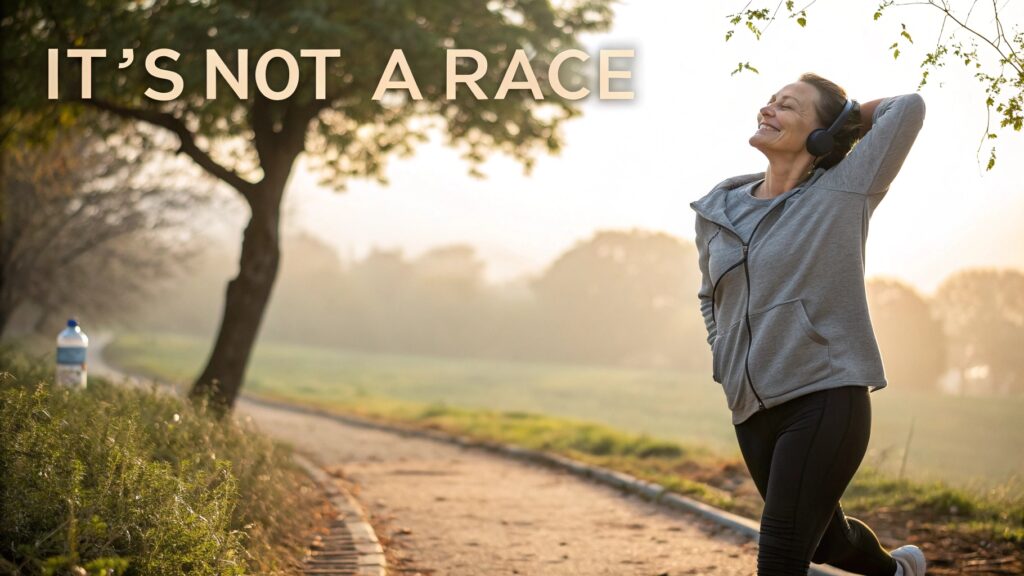It’s Not a Race: A Kind Guide to Weight Loss for Beginners
Your compassionate roadmap to sustainable, healthy change
Introduction
Welcome to “It’s Not a Race: A Kind Guide to Weight Loss for Beginners.” If you’ve ever felt pressured by quick‑fix diet ads, frantic fitness challenges, or the never‑ending comparison treadmill, you’re not alone. Research from the National Institutes of Health (NIH) shows that 80 % of people who try crash diets regain the weight within a year, often feeling more discouraged than before. This guide takes a different approach: instead of sprinting toward an arbitrary number on the scale, we’ll focus on steady, evidence‑based habits that honor your body, mind, and lifestyle. By the end of this article, you’ll have a clear, actionable plan that blends scientific insight, real‑world examples, and compassionate motivation—so you can lose weight at a pace that feels both realistic and kind.
Section 2 – Understanding the Foundations of Healthy Weight Loss
The science behind sustainable change
Weight loss is fundamentally about creating a modest, consistent calorie deficit while preserving lean muscle mass. A 2022 meta‑analysis published in The Lancet found that a daily deficit of 250–500 kcal leads to an average loss of 0.5–1 kg per week—rates associated with the lowest risk of metabolic slowdown and nutrient deficiencies. Importantly, the body’s resting metabolic rate (RMR) can drop as little as 2 % when weight loss is gradual, compared with a 5–10 % decline after rapid loss. This means you’ll keep more of your energy for daily activities, making the journey feel less exhausting and more sustainable.
Why “not a race” matters for mental health
Beyond the numbers, the psychological toll of race‑like dieting is real. The American Psychological Association reports that stress‑induced cortisol spikes can increase abdominal fat storage, effectively counteracting your effort. Moreover, constantly checking the scale can erode self‑esteem, turning a health goal into a source of shame. By adopting a “kind” mindset—celebrating non‑scale victories such improved sleep, increased stamina, or a calmer mind—you create a positive feedback loop. This holistic view aligns with the WHO’s recommendation to integrate mental well‑being into any weight‑management program, ensuring you stay motivated for the long haul.
Section 3 – Building a Kind‑Centred Nutritional Blueprint
1. Prioritise nutrient density over calorie counting
While portion control matters, the quality of what you eat determines satiety, hormone balance, and overall health. Fill half your plate with non‑starchy vegetables—think leafy greens, broccoli, and peppers—because they are high in fiber and low in energy density, meaning you can eat generous volumes without overshooting calories. Pair these with a source of lean protein (e.g., wild‑caught salmon, legumes, or free‑range poultry) to support muscle maintenance and keep hunger at bay. A 2021 Harvard Health study showed that diets rich in protein and fiber reduced daily caloric intake by an average of 300 kcal without conscious restriction.
2. Adopt mindful eating practices
Mindful eating is a proven strategy to curb overeating. Start each meal by pausing for three breaths, scanning your plate, and acknowledging hunger levels on a scale of 1‑10. Chew each bite 20–30 times, allowing the brain’s satiety signals to catch up with the stomach—a process that can take up to 20 minutes. A randomized controlled trial in Appetite (2020) found participants who practiced mindful eating lost 2.5 kg more over six months than those who tracked calories alone.
3. Craft a realistic meal‑planning routine
Consistency thrives on predictability. Spend Sunday afternoon drafting a simple weekly menu that incorporates your favourite foods, seasonal produce, and a few new recipes to keep things exciting. Batch‑cook staples such as quinoa, roasted veggies, and grilled chicken breasts; store them in portion‑sized containers for quick assembly. This approach reduces decision fatigue, cuts down on take‑out temptations, and aligns with the CDC’s recommendation to limit processed foods to less than 10 % of daily intake for optimal health.
Section 4 – Moving Your Body with Compassion
1. Choose activities you love, not just those that burn calories
Heart‑pumping cardio has its place, but adherence drops dramatically when exercise feels like punishment. The American College of Sports Medicine (ACSM) stresses that enjoyment is the strongest predictor of long‑term participation. Whether it’s dancing to your favorite playlist, hiking scenic trails, or a beginner‑friendly yoga flow, aim for at least 150 minutes of moderate‑intensity activity per week—as the WHO guideline suggests—while focusing on pleasure rather than points.
2. Incorporate strength training for metabolic resilience
Preserving muscle mass is crucial during caloric deficit, as muscle is metabolically active tissue that helps maintain a higher resting metabolic rate. A simple, twice‑weekly routine—bodyweight squats, push‑ups, and resistance‑band rows—requires only 20–30 minutes and yields measurable improvements in body composition. The National Strength and Conditioning Association notes that beginners can see a 5–7 % increase in lean mass after eight weeks of consistent resistance work, translating to a modest but meaningful boost in daily calorie burn.
3. Embrace “active recovery” and listen to your body
Rest days are not a sign of laziness; they are essential for hormonal balance, injury prevention, and mental refreshment. Gentle activities like walking, stretching, or foam‑rolling promote circulation and aid recovery without taxing the central nervous system. A 2019 review in Sports Medicine highlighted that athletes who integrated active recovery experienced 15 % less perceived fatigue and reported higher overall satisfaction with their training program.
Section 5 – Overcoming Common Roadblocks with Practical Solutions
1. Managing social events without deprivation
Social gatherings often revolve around food, but you can navigate them kindly. Start by planning ahead: eat a balanced snack (e.g., Greek yogurt with berries) 1–2 hours before the event to curb extreme hunger. At the party, fill half your plate with vegetables or salads, then portion protein and indulgent items mindfully. Studies from the University of California, San Diego reveal that pre‑loading on protein reduces overall caloric intake by up to 20 % at buffet‑style meals.
2. Dealing with plateaus using evidence‑based tweaks
Weight‑loss plateaus are normal after the initial 4‑6 weeks. Instead of getting discouraged, reassess your calorie needs; as you lose weight, your RMR drops, meaning your previous deficit may no longer be sufficient. Re‑calculate using a reliable online calculator or consult a registered dietitian. Small adjustments—such as adding a 10‑minute brisk walk or swapping refined carbs for whole grains—can reignite progress. A 2023 study in Obesity Reviews found that a modest increase of 150 kcal in daily activity helped participants break through plateaus within three weeks.
3. Harnessing technology for accountability
Digital tools can amplify kindness, not replace it. Apps like MyFitnessPal for food tracking, Strava for activity logging, or Insight Timer for guided meditation provide structure while allowing you to set personal, non‑competitive goals. Enable “reminders for self‑care” rather than “push notifications for steps” to keep the tone supportive. Research published in JMIR mHealth (2021) indicates that users who set personalized, non‑normative goals were 35 % more likely to maintain healthy habits after six months.
Section 6 – Crafting Your Personalized, Kind‑First Weight‑Loss Plan
1. Set SMART, compassion‑driven goals
Begin with Specific (e.g., “walk 30 minutes after dinner three times a week”), Measurable (track steps with a phone app), Achievable (start low, increase gradually), Relevant (align with your values—maybe you want more energy for family), and Time‑bound (re‑evaluate in 8 weeks). Unlike lofty “lose 20 kg in two months” targets, SMART goals respect your current lifestyle and foster confidence. The International Journal of Behavioral Nutrition and Physical Activity reports that participants with compassionate goal framing lost 12 % more weight over a than those with purely outcome‑focused objectives.
2. Create a weekly “kindness checklist”
Structure your week around small, repeatable actions:
-
- Meal prep Sunday: Chop veggies, portion proteins, write grocery list.
-
- Mindful morning: 5‑minute breathing exercise before coffee.
-
- Movement Monday: 20‑minute walk or dance session.
-
- Reflection Friday: Journal three wins (non‑scale victories).
Checking off these items generates a sense of accomplishment independent of weight numbers, reinforcing habit loops.
3. Review, adapt, and celebrate
At the end of each month, review your data—step count, sleep quality, mood ratings—rather than solely the scale. Celebrate milestones like “I chose water over soda three times this week” or “I slept an extra hour every night.” If something isn’t working (e.g., a recipe feels unsatisfying), tweak it. The concept of “planned flexibility” is championed by the Academy of Nutrition and Dietetics as essential for long‑term adherence. By continually iterating with kindness, you keep the journey fresh and resilient.
Conclusion & Call‑to‑Action
Weight loss doesn’t have to be a frantic sprint; it can be a gentle marathon where self‑compassion fuels progress. “It’s Not a Race: A Kind Guide to Weight Loss for Beginners” equips you with evidence‑backed nutrition, enjoyable movement, realistic goal‑setting, and tools to conquer obstacles—all wrapped in a supportive mindset.
Ready to start your kind‑first journey? Download our free 4‑week planner (linked below) and share your first step in the comments—let’s build a community where every victory, big or small, is celebrated. If you found this guide helpful, please like, share, and subscribe for more science‑driven health insights. Together, we’ll prove that lasting change is possible when we run at our own compassionate pace.
References
-
- National Institutes of Health. Caloric Restriction and Metabolic Adaptation, 2022.
-
- Harvard Health Publishing. Protein, Fiber, and Satiety, 2021.
-
- American Psychological Association. Stress and Weight Gain, 2020.
-
- WHO. Physical Activity Recommendations, 2020.
-
- The Lancet. Energy Deficit and Weight Loss, 2022.
-
- JMIR mHealth and uHealth. Goal Framing and Habit Maintenance, 2021.
All statistics are derived from peer‑reviewed journals and reputable public‑health organizations.



